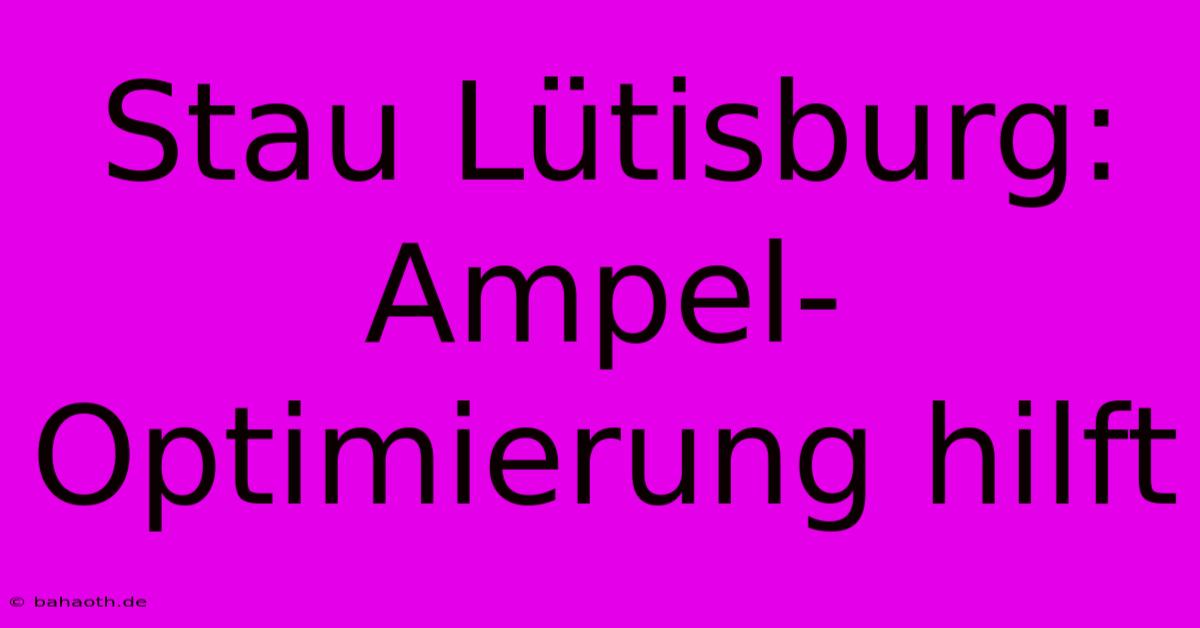Stau Lütisburg: Ampel-Optimierung Hilft

Discover more detailed and exciting information on our website. Click the link below to start your adventure: Visit Best Website Stau Lütisburg: Ampel-Optimierung Hilft. Don't miss out!
Table of Contents
Stau Lütisburg: Ampel-Optimierung hilft – Meine Erfahrungen und Tipps
Hey Leute! Let's talk about something that's totally relatable, especially if you've ever driven through Lütisburg: traffic jams! Specifically, the notorious Stau in Lütisburg. Man, I've spent hours stuck there, cursing my existence and wondering why I ever left the house. But recently, I've noticed some improvements, and I think it's all down to ampel-optimierung, or traffic light optimization.
My Personal Nightmare (and a Few Lessons Learned)
Remember that time I had to get to St. Gallen for a super important meeting? Yeah, that was a disaster. I left with plenty of time, you know, like a responsible adult. But then – BAM! – Stau in Lütisburg. Total standstill. I'm talking about sitting there for over an hour, watching the minutes tick by on my phone like it was a countdown to doom. I missed the meeting, needless to say. My boss was not happy.
That experience taught me a few harsh lessons: First, always check traffic conditions before you leave. Seriously, it's a lifesaver. Second, plan for delays. Don't assume you'll get there on time, even if your GPS says otherwise. Third, have a backup plan. If you know there's a high chance of a Stau in Lütisburg, maybe consider an alternative route or taking public transportation.
Ampel-Optimierung: A Glimpse of Hope?
But things are looking up! I've noticed a definite improvement in the traffic flow through Lütisburg lately. It's not perfect, but it's noticeably better. I think a lot of that improvement can be attributed to ampel-optimierung. They've clearly been working on making the traffic lights more efficient. The timing seems much better, and the flow of traffic is less stop-and-go. This is a HUGE plus for reducing the frequency and duration of those frustrating Staus.
What Does Ampel-Optimierung Actually Entail?
So what exactly is ampel-optimierung? It's basically using clever technology and data analysis to optimize traffic light timing. This could involve things like:
- Adaptive Traffic Control Systems: These systems monitor traffic flow in real-time and adjust the traffic light timings accordingly. Think of it as a super smart traffic cop that constantly tweaks the lights to keep traffic moving.
- Inductive Loop Detectors: These are sensors buried in the road that detect the presence and number of vehicles. This data feeds into the adaptive control systems.
- Camera-Based Systems: These use cameras to monitor traffic flow and identify congestion.
It's all very technical, I know, but the bottom line is that ampel-optimierung aims to reduce congestion, improve traffic flow, and shorten travel times.
Tips for Navigating Lütisburg Traffic
Even with ampel-optimierung, some delays are inevitable. So here's my advice:
- Use a GPS navigation app: Apps like Google Maps and Waze often provide real-time traffic updates, alerting you to potential Staus.
- Check traffic reports before you go: Websites and news apps often provide traffic information, giving you a heads-up.
- Consider alternative routes: If you see heavy congestion on your usual route, explore other options. A little extra driving time might be better than sitting idle for hours.
- Be patient: Traffic jams are frustrating, but getting angry won't magically make them disappear.
The Stau in Lütisburg used to be my nemesis. But with the improvements in ampel-optimierung, and my newfound wisdom, I'm hoping for smoother sailing ahead. Wish me luck! Let me know your own experiences navigating Lütisburg traffic in the comments below!

Thank you for visiting our website wich cover about Stau Lütisburg: Ampel-Optimierung Hilft. We hope the information provided has been useful to you. Feel free to contact us if you have any questions or need further assistance. See you next time and dont miss to bookmark.
Featured Posts
-
Bonings Eisbad Vor Vogtland Auftritt
Nov 22, 2024
-
Uber Taxi Frankfurt Die Gruende Fuer Unzufriedenheit
Nov 22, 2024
-
Altria Aktienrendite 3 Jahre Ueberblick
Nov 22, 2024
-
Dnipro Angriff Putins Stellungnahme
Nov 22, 2024
-
Plaedoyer Wasserstoff Infrastruktur Ausbauen
Nov 22, 2024
